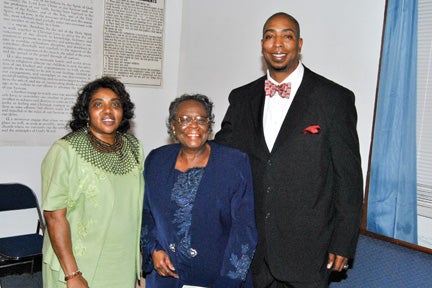Lowndesboro School honors former teacher, continues care of building
Published 11:22 am Thursday, February 28, 2013

Helen Stallworth, left, and Dandrea J. Evans Sr., right, vice president and president of the Lowndesboro School Alumni Association, join Lizzie Johnson Thomas, the last living teacher from the circa 1868 constructed Lowndesboro School.
By Fred Guarino
The Lowndes Signal
Efforts to restore the old Lowndesboro School continued Saturday when the Lowndesboro School Alumni Association held a “History Markers” program to honor Lizzie Johnson Thomas, the last living teacher from the school that was founded in the 19th century.
The event was held at Lowndesboro First Missionary Baptist Church. However, according to Josephine B. McCall, president of the Elmore Bolling Foundation Inc., to which the old school was donated, funds are needed to continue restoration efforts.
Thomas was presented roses and pinned with a three-rose corsage for her work. She taught a total of 38 years in the Lowndes County Public School System.
The event also included a presentation of school history by Helen Stallworth, vice president of the Lowndesboro School Alumni Association, and a panel discussion with Ila Mae Coleman, Ted Bozeman, Agnita Crittenden, Annie Clyde Hunter and Eli Seaborn.
Stallworth said the State of Alabama was authorized to spend $600 from the Bureau of Refugees, Freedmen and Abandoned Lands for the school’s construction in 1870.
She said the property, “formerly known as Lowndesboro Male Academy lot” was deeded by Mansfield Tyler to the Trustees of the Lowndesboro Colored Education Association in 1883.
Dr. Tyler, a former slave, served in the Alabama State Legislature from 1870-1872 and established the Lowndesboro First Missionary Baptist Church in 1880, which was where Saturday’s event was held.
She also said the school was placed on the Alabama Register of Landmarks and Heritage in 2011 and during that same year, Lucius and Myrtle K. Evans donated the school to the Elmore Bolling Foundation for preservation and restoration.
During a panel discussion, Crittenden remembered teachers: Clara Bertha Scott, Clara McGinnis Bell, Cora Capleton and Virginia Smith McCall.
Crittenden taught nine years at Lowndes County Training School (now Central). Coleman mentioned that the other schools in the district would meet at Lowndesboro School to promote reading. She taught at Hopewell, Meadows and Bell Schools.
Bozeman said he “was not a regular student, but often did not go to his assigned school and visited Lowndesboro School.” He recalled that he occasionally was given recitations and participated in the school’s programs at the Lowndesboro Church.
Seaborn emphasized how “effective learning took place in a setting not designed to produce learning.” He said the preparedness and dedication of the teachers were responsible for the success of the students.
Hunter, who taught in Lowndes County Public Schools for 32 and half years, mentioned the achievements of her former students.
The alumni of the school, led by Bright Lee, talked about “the way we were.” Lee said the boys gathered firewood and obtained water from the nearby spring.
It was also pointed out that while Clara Scott’s sister provided her with a hot lunch daily, the school children often brought their lunches in paper bags and “tin pails.”
Seaborn also spoke about the times when school consolidation occurred in the county. He mentioned the occasion in 1961 when Russell and Ft. Deposit schools opened. He also said Dr. Martin Luther King and the Civil Rights Movement were responsible for the consolidation that occurred after the march from Selma to Montgomery.
Seaborn said attention was focused on the county and a picture of a shanty school, probably Rollen, which was on Highway 80 next to Mt Gillard Church, appeared in The New York Times.
It was reported that some 30 plantation/church schools closed and the newly erected White Hall School opened in 1967 with Seaborn as its principal. The Lowndesboro School closed at this time.
Other program participants included The Angels in Harmony and the Praise Dance Team of Lowndesboro Missionary Baptist Church. Wayne Taylor, president of the Lowndesboro Landmarks Foundation, and Laura Ward attended.
According to the Elmore Bolling Foundation Inc., grants were received from the Alabama Historical Commission, the National Trust for Historic Preservation Gwyn Tuner Preservation Fund, the Lowndes County Commission and the town of Lowndesboro.
However, according to McCall, restoration funds have been “depleted.”
She said so far the building has been stabilized, but the Elmore Bolling Foundation Inc. is seeking funds to continue the restoration effort.
“The building will be used to inform the public on education for blacks in Lowndes County and Alabama pre and post reconstruction to address the needs of the at risk population, job training and to house a cultural center for educational outreach through the arts,” the Elmore Bolling Foundation reports.
Stallworth said Saturday’s celebration was intended to get everyone together who went to the school, honor one of the teachers and to reunite.
“One thing we would all like to do is pass along the roses while people are still living,” Dandrea J. Evans Sr., president of the Lowndesboro School Alumni Association said. “We realized that we have one remaining teacher who’s still living who taught at the school and we wanted to recognize her and let her know that we are trying to restore the school and make it a historic landmark whereby the time that she shared teaching the students that went there will be remembered in some form.”
Thomas said she taught at the old school in the later part of the 1950’s.
“We were coming to a two and three-room school,” she said. “And there were less children to work with at that time and not too many books. So, we did the best we could with what we had.”
She said parents back then were “excellent” because “they were loving and worked close with the teachers at that time.”





